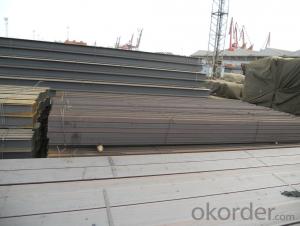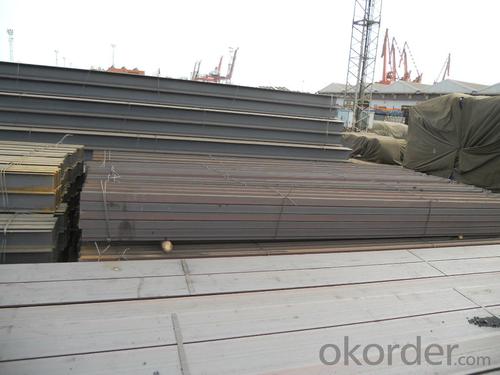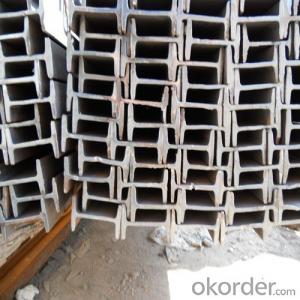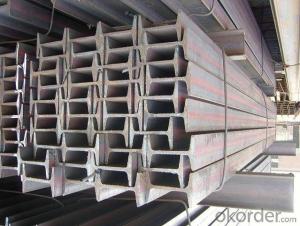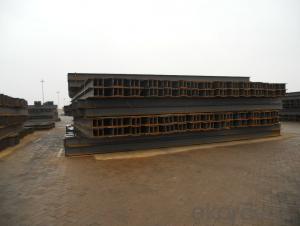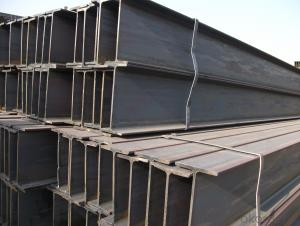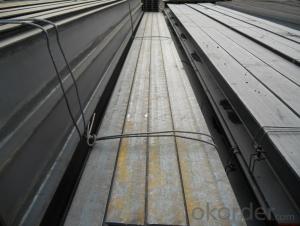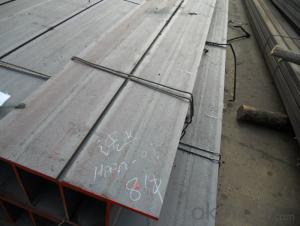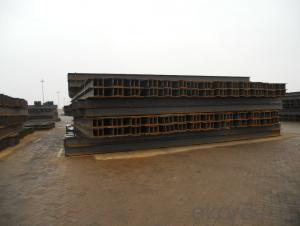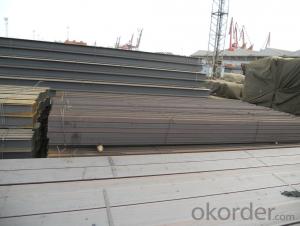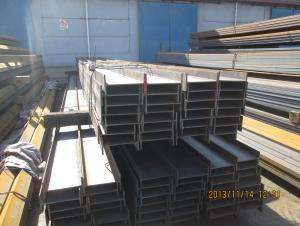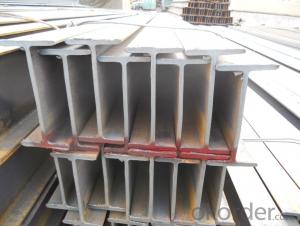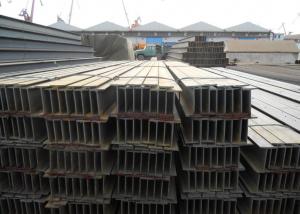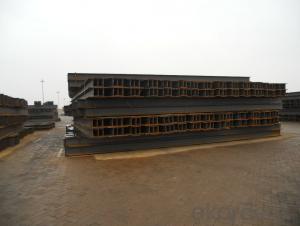Hot Rolled Steel JIS Standard H-beam Bar
- Loading Port:
- Shanghai
- Payment Terms:
- TT or LC
- Min Order Qty:
- 25 m.t.
- Supply Capability:
- 1000 m.t./month
OKorder Service Pledge
OKorder Financial Service
You Might Also Like
Product Description:
OKorder is offering Structural Steel H-beam JIS Standard at great prices with worldwide shipping. Our supplier is a world-class manufacturer of steel, with our products utilized the world over. OKorder annually supplies products to European, North American and Asian markets. We provide quotations within 24 hours of receiving an inquiry and guarantee competitive prices.
Product Applications:
Commercial building structure ;Pre-engineered buildings; Machinery support structure; Prefabricated structure; Medium scale bridges; Ship-building structure. etc.
Product Advantages:
OKorder's Structural Steel H-beam JIS Standard are durable, strong, and resist corrosion.
Main Product Features:
· Premium quality
· Prompt delivery & seaworthy packing (30 days after receiving deposit)
· Corrosion resistance
· Can be recycled and reused
· Mill test certification
· Professional Service
· Competitive pricing
Product Specifications:
1. Standard: JIS
2. Grade: SS400
3. Length: 12m
4. Invoicing on theoretical weight or actual weight as customer request
5.Payment: TT or L/C
6. Sizes:
H x B
(mm)
| T1 | T2 | JIS Weight
(kg/m)
| GB Weight
(kg/m)
|
100*100 | 6 | 8 | 16.9 | 17.2 |
125*125 | 6.5 | 9 | 23.6 | 23.8 |
150*75 | 5 | 7 | 14 | 14.3 |
148*100 | 6 | 9 | 20.7 | 21.4 |
150*150 | 7 | 10 | 31.1 | 31.9 |
175*90 | 5 | 8 | 18 | 18.2 |
175*175 | 7.5 | 11 | 40.4 | 40.4 |
198*99 | 4.5 | 7 | 17.8 | 18.5 |
200*100 | 5.5 | 8 | 20.9 | 21.7 |
194*150 | 6 | 9 | 29.9 | 31.2 |
200*200 | 8 | 12 | 49.9 | 50.5 |
248*124 | 5 | 8 | 25.1 | 25.8 |
250*125 | 6 | 9 | 29 | 29.7 |
244*175 | 7 | 11 | 43.6 | 44.1 |
250*250 | 9 | 14 | 71.8 | 72.4 |
298*149 | 5.5 | 8 | 32 | 32.6 |
298*201 | 9 | 14 | 65.4 | |
300*150 | 6.5 | 9 | 36.7 | 37.3 |
294*200 | 8 | 12 | 55.8 | 57.3 |
300*300 | 10 | 15 | 93 | 94.5 |
346*174 | 6 | 9 | 41.2 | 41.8 |
350*175 | 7 | 11 | 49.4 | 50 |
340*250 | 9 | 14 | 78.1 | 79.7 |
350*350 | 12 | 19 | 135 | 137 |
400*200 | 8 | 13 | 65.4 | 66 |
390*300 | 10 | 16 | 105 | 107 |
400*400 | 13 | 21 | 172 | 172 |
446*199 | 8 | 12 | 65.1 | 66.7 |
450*200 | 9 | 14 | 77.9 | 79.5 |
440*300 | 11 | 18 | 121 | 124 |
496*199 | 9 | 14 | 77.9 | 79.5 |
500*200 | 10 | 16 | 88.2 | 89.6 |
488*300 | 11 | 18 | 125 | 129 |
596*199 | 10 | 15 | 92.5 | 95.1 |
600*200 | 11 | 17 | 103.4 | 106 |
588*300 | 12 | 20 | 147 | 151 |
700*300 | 13 | 24 | 182 | 185 |
800*300 | 14 | 26 | 207 | 210 |
900*300 | 16 | 28 | 240.1 | 243 |
Usage & Applications of Hot Rolled Steel H-beam For Sale
Commercial building structure ;Pre-engineered buildings; Machinery support structure; Prefabricated structure; Medium scale bridges; Ship-building structure.etc.
Packaging & Delivery of Hot Rolled Steel H-beam For Sale
1. Packing: it is nude packed in bundles by steel wire rod
2. Bundle weight: not more than 3.5MT for bulk vessel; less than 3 MT for container load
3. Marks:
Color marking: There will be color marking on both end of the bundle for the cargo delivered by bulk vessel. That makes it easily to distinguish at the destination port.
Tag mark: there will be tag mark tied up on the bundles. The information usually including supplier logo and name, product name, made in China, shipping marks and other information request by the customer.
If loading by container the marking is not needed, but we will prepare it as customer request.
4. Transportation: the goods are delivered by truck from mill to loading port, the maximum quantity can be loaded is around 40MTs by each truck. If the order quantity cannot reach the full truck loaded, the transportation cost per ton will be little higher than full load.
5. Delivered by container or bulk vessel
Production flow of Hot Rolled Steel H-beam For Sale
Material prepare (billet) —heat up—rough rolling—precision rolling—cooling—packing—storage and transportation
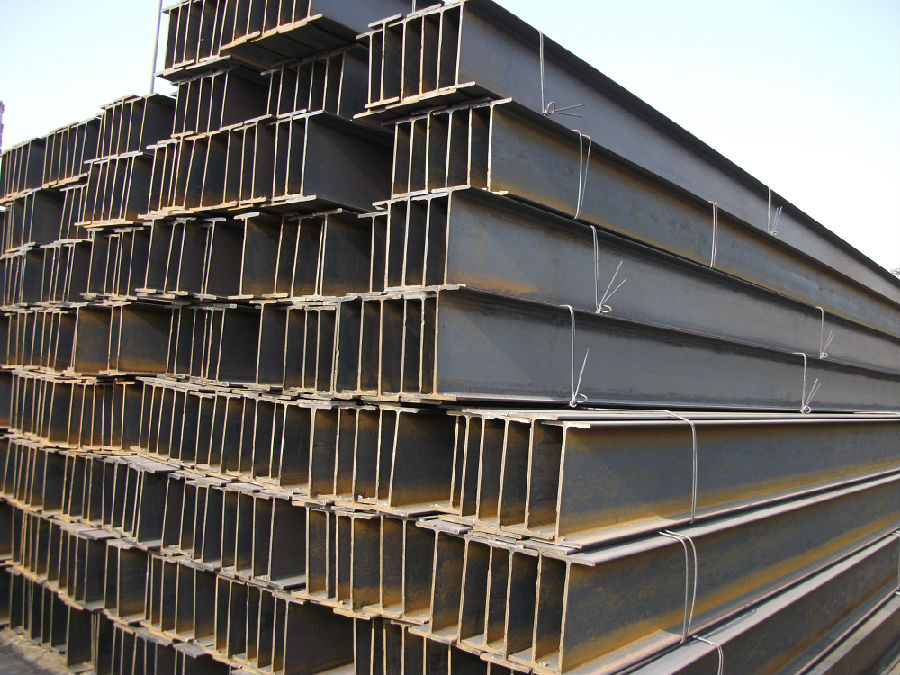
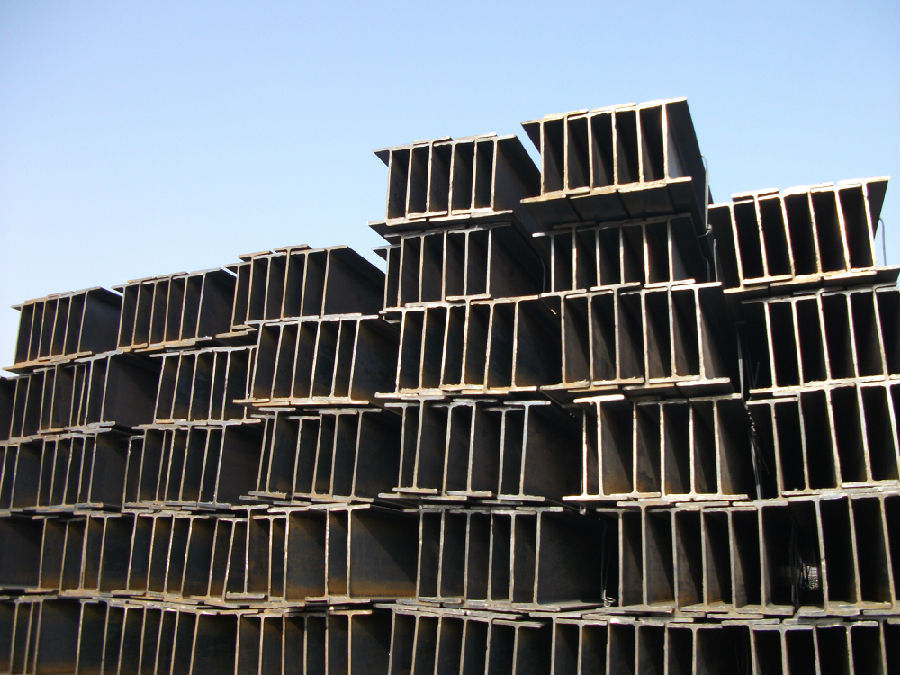
FAQ:
Q1: Why buy Materials & Equipment from OKorder.com?
A1: All products offered byOKorder.com are carefully selected from China's most reliable manufacturing enterprises. Through its ISO certifications, OKorder.com adheres to the highest standards and a commitment to supply chain safety and customer satisfaction.
Q2: How do we guarantee the quality of our products?
A2: We have established an advanced quality management system which conducts strict quality tests at every step, from raw materials to the final product. At the same time, we provide extensive follow-up service assurances as required.
Q3: How soon can we receive the product after purchase?
A3: Within three days of placing an order, we will begin production. The specific shipping date is dependent upon international and government factors, but is typically 7 to 10 workdays.
Q4: What makes stainless steel stainless?
A4: Stainless steel must contain at least 10.5 % chromium. It is this element that reacts with the oxygen in the air to form a complex chrome-oxide surface layer that is invisible but strong enough to prevent further oxygen from "staining" (rusting) the surface. Higher levels of chromium and the addition of other alloying elements such as nickel and molybdenum enhance this surface layer and improve the corrosion resistance of the stainless material.
- Q: How do steel H-beams contribute to the overall sustainability of a transportation hub?
- There are several ways in which the overall sustainability of a transportation hub is enhanced by steel H-beams. First and foremost, the structural strength and durability of steel H-beams make them an excellent choice for constructing large-scale transportation hubs. With their high strength-to-weight ratio, H-beams require fewer materials to provide the necessary structural support. This not only conserves natural resources but also reduces the environmental impact associated with material extraction, manufacturing, and transportation. Moreover, steel H-beams are recyclable, meaning they can be repurposed or reused once their lifespan is complete. This aligns with the principles of a circular economy, which seeks to minimize waste and maximize resource efficiency. By incorporating recyclable materials like steel H-beams into transportation hub construction, we can decrease the amount of construction waste sent to landfills and promote a more sustainable approach to infrastructure development. Additionally, steel H-beams offer exceptional resistance to extreme weather conditions. They can withstand high winds, earthquakes, and heavy loads, ensuring the long-term stability and safety of transportation hubs. This durability reduces the need for frequent repairs or replacements, saving time and resources in the long run. Lastly, steel H-beams can be prefabricated offsite, allowing for efficient construction processes and minimizing disruption to the surrounding environment. Prefabrication decreases construction time, energy consumption, and waste generation, all of which contribute to the overall sustainability of the transportation hub. In conclusion, steel H-beams have a crucial role in enhancing the overall sustainability of transportation hubs. Their strength, durability, recyclability, resistance to extreme weather, and ability to be prefabricated all contribute to reducing resource consumption, promoting a circular economy, minimizing waste, and ensuring long-term stability. By incorporating steel H-beams into transportation hub design and construction, we can create more sustainable and resilient infrastructure for the future.
- Q: Can Steel H-Beams be used in laboratory or research facility construction?
- Yes, Steel H-Beams can be used in laboratory or research facility construction. They are commonly used for their structural strength, durability, and ability to support heavy loads. Steel H-Beams provide stability and are often preferred for their resistance to fire, earthquakes, and other potential hazards. Furthermore, their versatility allows for easy integration into various architectural designs and flexible space arrangements.
- Q: What are the considerations when designing for acoustical isolation of Steel H-Beams?
- When designing for acoustical isolation of Steel H-Beams, several considerations need to be taken into account. Firstly, it is important to analyze the structural properties of the H-Beams, such as their dimensions, material composition, and connection details, as these factors can influence their ability to transmit sound. Additionally, the design should incorporate appropriate measures to mitigate the transmission of airborne and impact noise through the beams. This may involve incorporating soundproof materials, such as acoustical barriers or resilient mounts, into the design. It is also crucial to consider the surrounding environment and potential sources of noise, as well as the desired level of acoustic isolation required. Overall, a comprehensive approach that addresses both the structural and acoustic aspects is necessary to achieve effective acoustical isolation of Steel H-Beams.
- Q: Can steel H-beams be used in the construction of schools or educational buildings?
- Yes, steel H-beams can be used in the construction of schools or educational buildings. Steel H-beams are commonly used in construction due to their high strength and durability. They provide structural support and stability to buildings, making them suitable for educational facilities that require long-lasting and stable structures. Additionally, steel H-beams can be prefabricated, allowing for faster construction times and cost-effectiveness, which are important factors in educational building projects.
- Q: How do steel H-beams perform in earthquake-prone areas?
- Steel H-beams are widely used in earthquake-prone areas due to their exceptional performance and structural integrity during seismic events. The design and construction of H-beams make them highly resistant to the forces generated by earthquakes, ensuring the safety of buildings and structures. One key advantage of steel H-beams is their high strength-to-weight ratio. They are manufactured using high-quality steel, which provides excellent tensile strength and stiffness. This enables them to withstand the lateral and vertical forces exerted by earthquakes without compromising their structural integrity. Moreover, H-beams have a symmetrical shape that distributes the seismic forces evenly throughout the entire structure. This balanced load distribution helps prevent concentrated stress points, reducing the risk of structural failure during an earthquake. Additionally, the wide flanges of H-beams provide increased resistance to bending and shear forces, further enhancing their performance in seismic events. Steel H-beams also offer excellent ductility, which is the ability of a material to deform without breaking. During earthquakes, the ground undergoes significant shaking, causing buildings to vibrate and deform. The ductility of steel allows H-beams to absorb and dissipate a significant amount of energy, reducing the risk of sudden failure. This property ensures that H-beams can withstand the dynamic forces during an earthquake and provide a stable structure for the building. Another advantage of steel H-beams is their ease of installation and adaptability. They can be prefabricated off-site, allowing for faster construction and reduced labor costs. Additionally, H-beams can be easily connected and integrated with other structural components, such as concrete or steel columns, to create a robust and earthquake-resistant building system. In conclusion, steel H-beams are a reliable choice for earthquake-prone areas due to their high strength, balanced load distribution, ductility, and ease of installation. Their outstanding performance ensures the safety and stability of structures during seismic events, providing peace of mind to residents and occupants.
- Q: What does "H400*250*8*12" mean in steel structures?
- A direct consequence of low industrial concentration is caused by excessive competition, in 2005, the average profit of 5% steel enterprises, in addition, steel tube truss and complicated structure, difficult construction of landmark projects to higher profit margins, as building light steel portal frame, due to intense competition, the profit space is generally low, so only there are some enterprises in order to steal frugal material bidding, so only the sensation of three-dimensional "white paper". But the good news is the processing capacity of 13 million 510 thousand tons of steel structure steel structure association in 2005 statistics, the processing capacity of the top five steel enterprises has more than 1 million tons, the annual top ten enterprises the basic processing capacity in more than 100 thousand tons.
- Q: Can steel H-beams be used in the construction of cultural complexes or museums?
- Certainly, cultural complexes or museums can utilize steel H-beams for construction purposes. The widespread use of steel H-beams in various construction projects is due to their strength, durability, and versatility. These beams offer exceptional structural support, making them appropriate for the construction of large and intricate structures, such as cultural complexes or museums. To accommodate a variety of exhibits, displays, and visitor traffic, cultural complexes and museums often necessitate distinctive architectural designs and open spaces. Steel H-beams can facilitate the creation of expansive open spaces without the need for multiple supporting columns. Consequently, this allows for flexible floor plans and uninterrupted views. In cultural complexes and museums, this is particularly crucial as it permits unrestricted movement of visitors and facilitates the display of sizable artworks or artifacts. Moreover, steel H-beams are renowned for their capacity to withstand substantial loads and provide stability. This quality proves vital in cultural complexes and museums, where exhibits, artworks, and other installations can bear significant weight. Steel H-beams efficiently bear these loads, ensuring the structural integrity and safeguarding of valuable cultural assets. Additionally, steel H-beams are highly adaptable and can be seamlessly integrated into diverse architectural designs. They can be combined with materials such as glass or concrete, resulting in visually appealing and contemporary structures. Furthermore, steel H-beams offer considerable flexibility in terms of design, enabling architects to create distinctive and iconic structures that accurately reflect the cultural significance of the complex or museum. In conclusion, steel H-beams are an excellent choice for the construction of cultural complexes or museums. Their strength, durability, and versatility render them suitable for supporting large and intricate structures. Furthermore, their ability to withstand heavy loads ensures the preservation and safety of cultural assets. Additionally, their adaptability empowers architects to fashion visually captivating and iconic designs that accurately convey the cultural significance of the project.
- Q: What are the common methods of joining steel H-beams?
- Different methods exist for joining steel H-beams, depending on the application and desired connection strength and durability. Some commonly employed techniques include: 1. Welding: The most prevalent method involves melting the edges of the H-beams and fusing them together using a filler material. This creates a permanent bond and can be accomplished through various welding techniques, such as arc welding (MIG or TIG), flux-cored arc welding, or submerged arc welding. 2. Bolting: This method is favored for temporary or removable structures. It entails drilling holes in the H-beam flanges and inserting bolts through them. Nuts are then tightened onto the bolts to secure the connection, allowing for easy disassembly and reassembly if required. 3. Riveting: An older technique involving driving a metal pin (rivet) through aligned holes in the H-beam flanges. The ends of the rivet are then hammered or pressed to create a second head, securing the connection. While strong and reliable, riveting is labor-intensive and less commonly used today. 4. Adhesive bonding: High-strength structural adhesives are used to join H-beams in this method. It necessitates a clean and properly prepared surface, with the adhesive applied between the mating surfaces. Adhesive bonding provides a strong and aesthetically pleasing bond, though it may not be suitable for high-load applications. 5. Mechanical fasteners: Steel plates or angle brackets can be utilized as mechanical fasteners. These are typically bolted or welded to the H-beams, reinforcing the connection and enhancing strength and stability. Mechanical fasteners are often combined with other joining methods to achieve optimum results. When choosing the appropriate joining method for steel H-beams, it is crucial to consider project-specific requirements such as load-bearing capacity, structural integrity, and ease of assembly/disassembly. Seeking advice from a structural engineer or industry professional can prove invaluable in selecting the most suitable approach.
- Q: Are steel H-beams suitable for use in the construction of sports facilities?
- Steel H-beams are indeed suitable for use in the construction of sports facilities. They are widely utilized in construction owing to their robustness, endurance, and versatility. Their ability to bear heavy loads makes them perfect for providing support to large structures like sports arenas, stadiums, and gymnasiums. Furthermore, H-beams ensure exceptional structural integrity, guaranteeing the safety and stability of the sports facility. Moreover, steel H-beams offer easy fabrication and installation, enabling efficient construction and reduced construction time. All in all, steel H-beams are a dependable and cost-effective option for building sports facilities, effectively meeting the specific requirements and demands of such structures.
- Q: What are the different sizes and dimensions of steel H-beams?
- Steel H-beams come in various sizes and dimensions to meet different construction and engineering needs. The sizes and dimensions of steel H-beams are typically categorized by their depth (height), flange width, and weight per foot. The depth of an H-beam refers to the vertical distance from the top to the bottom flange. Common depths for steel H-beams range from 4 inches to 24 inches, with increments of 2 inches. However, deeper depths may also be available for specialized applications. The flange width of an H-beam is the horizontal width of the top and bottom flanges. Standard flange widths can range from 4 inches to 12 inches, with increments of 1 inch. Like the depth, wider flange widths may be available for specific requirements. The weight per foot of an H-beam is an important dimension that determines the load-bearing capacity. It is measured in pounds per linear foot (plf) and varies depending on the size and dimensions of the H-beam. The weight per foot can range from 17 plf to 300 plf or more, depending on the specific H-beam size. It is important to note that the sizes and dimensions of steel H-beams can vary across different countries and regions. For example, the American Society for Testing and Materials (ASTM) standardizes H-beam sizes in the United States, while the European Norm (EN) standardizes them in Europe. These standards may have slight variations in sizes and dimensions. In summary, steel H-beams come in various sizes and dimensions, with variations in depth, flange width, and weight per foot. These variations allow for the selection of the most suitable H-beam for specific construction or engineering applications.
Send your message to us
Hot Rolled Steel JIS Standard H-beam Bar
- Loading Port:
- Shanghai
- Payment Terms:
- TT or LC
- Min Order Qty:
- 25 m.t.
- Supply Capability:
- 1000 m.t./month
OKorder Service Pledge
OKorder Financial Service
Similar products
Hot products
Hot Searches
Related keywords
